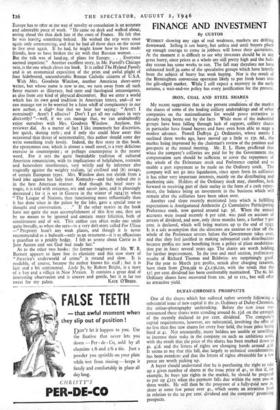FINANCE AND INVESTMENT
By CUSTOS
WITHOUT showing any sign of real weakness, markets are drifting downward. Selling is not heavy, but unless and until buyers pluck up enough courage to come in jobbers will lower their quotations. At the moment it is difficult to see why investors should be in any great hurry, since prices as a whole are still pretty high and the holi- day season has some weeks to run. The fall may therefore not have exhausted itself in some of the speculative groups which have latterly been the subject of heavy but weak buying. Nor is the result of the Birmingham conversion operation likely to put fresh heart into the gilt-edged market. While I still expect a recovery in the early autumn, a wait-and-see policy has every justification for the present.
IRON, COAL AND STEEL SHARES
My recent suggestion that in the present conditions of the market the shares of sortie of the leading colliery undertakings and of other companies on the nationalisation list would prove attractive is already being borne out by the facts. While most of the industrial groups have been falling through lack of support, colliery shares in particular have found buyers and have even been able to stage a modest advance. Powell Duffryn Li Ordinaries, whose merits I outlined three weeks ago, have moved up a little to 23s. 6d., the market being impressed by the chairman's review of the position and prospects at the annual meeting. Mr. E. L. Hann predicted that when the company's collieries are paid for by the Government the compensation sum should be sufficient to cover the repayment of the whole of the Debenture stock and Preference capital and to enable a part repayment to be made on the Ordinary stock. The company will not go into liquidation, since apart from its collieries it has other very important interests, mainly on the distributing and marketing side. Holders of the Ordinary stock may, therefore, look forward to receiving part of their outlay in the form of a cash repay- ment, the balance being an investment in the 'business which will remain after the collieries have been taken over.
Another coal share recently mentioned here which is fulfilling expectations is Amalgamated Anthracite Li Cumulative Participating Preference stock, now quoted around 14s. 3d. When the annual accounts were issued recently 6 per cent. was paid on account of arrears of dividend, and now, only three months later, a further 7 per cent. is declared, which will bring matters up to the end of 1943. It is a safe assumption that the directors are anxious to clear off the whole of the Preference arrears before the Government takes over, and that they feel justified in making substantial cash distributions because profits are now benefiting from a policy of plant modeinisa- don put in force several years ago. The shares are worth holding, for further improvement. In the iron and steel section, preliminary results of Richard Thomas and Baldwins are surprisingly good. For the year to March 3ist profits, struck after charging taxation, have risen from L819,599 to £1,136,120, with the result that the 121- per cent. dividend has been comfortably maintained. The 6s. 8d. Ordinary shares have recovered from los. 3d to its., but still offer an attractive yield.
DUFAY-CHROMEX PROSPECTS
One of the shares which has suffered rather severely following a substantial issue of new capital is the 2s. Ordinary of Dufay-Chromex, the colour-photography undertaking. Before the new issue was announced these shares were standing around 6s. zid. on the strength of the recently declared to per cent, dividend. The company's capital requirements, however, are substantial, involving the offer of no less than five new shares for every four held, the issue price being fixed at 43. Not unnaturally, many holders are unable or unwilling to increase their stake in the company_ on such an ambitious scale, with the result that the price of the shares has been marked dcwn to 4s. 41d. and the letters of rights are changing hands around 4;c1. It seems to me that this fall, due largely to technical considerations, has been overdone and that the letters of rights obtainable for a few pence are worth picking up. A buyer should understand that he is purchasing, the right to take up a given number of shares at the issue price of 4s., so that if, for example, he buys soo rights in the market, he should be prepared to put up £125 when the payment falls due within the next two or three weeks. He will then be the possessor of a fullyLpaid new 2S. share at some few pence over 4s.. which seems an attractive level in relation to the to per cent. dividend and the company' promising prospects.


























 Previous page
Previous page